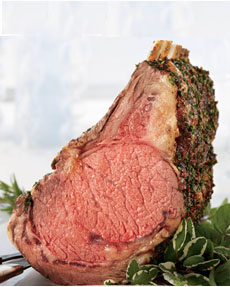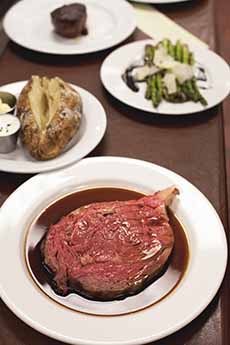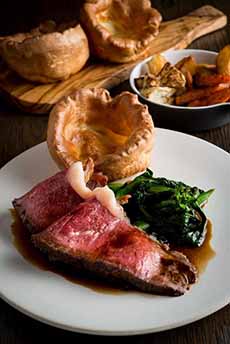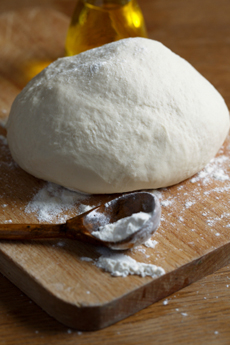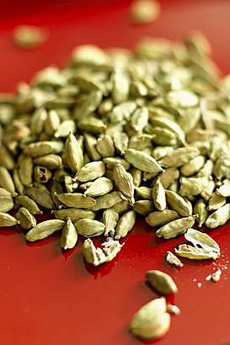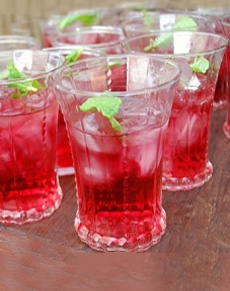|
Many families enjoy prime rib for the holidays. At our mother’s house, a bone-in prime rib (a.k.a. standing rib roast) was always on the holiday table.
Jan Birnbaum, Executive Chef at Epic Steak, a steakhouse on the San Francisco waterfront (great view of the Bay Bridge!), shares this advice so that you, too can cook the perfect prime rib.
April 27th is National Prime Rib Day.
> Do you know your cuts of beef? See them all in our Beef Glossary.
START WITH THE BUTCHER
Frenched
Ask for an 8-bone (approximately 14-18 pounds), bone-in beef rib export*, bones frenched 2 inches. This will serve about 15-20 people. (If you’re having fewer guests, discuss your needs with the butcher.)
Fat Cap
Ask the butcher to cut the fat cap so that it has a half-fat layer that has been cut and lifted, and only the bottom is attached to the rib. This attached fat cap will provide a perfect pocket in which to pack the aromatics.
INGREDIENTS
Aromatics
Prepare the aromatics: In a mixing bowl, toss the following ingredients until combined:
2 white onions (skinned and cut julienne style)
6 bay leaves (crushed and broken into half-inch pieces)
4 ounces course sea salt
3 ounces coarsely ground black pepper
PREPARATION
SEASON. Lift the fat cap that has been cut from the export with the bottom attached and lay the onion mixture against the flesh. With butchers twine, tie the cap back on, going around the circumference of the rib, in between the bones, or in 4 to 5 places.
ROOM TEMPERATURE. Never cook cold meat. Allow the meat to temper on the counter for at least one hour.
PREHEAT. Preheat the oven to 500°F. (Put convection ovens on high fan.)
ROASTING PAN. Lay the rib on a rack with the bones facing up.
SEASONING. Season the outside of the meat bone side with salt and pepper. At THE NIBBLE, we also like a sprinkling of rosemary.
COOKING THE PRIME RIB
1. PLACE the meat into the oven with the bones facing front and the meaty part of the rib facing the back of the oven. Cook for 35 minutes.
2. LOWER HEAT. Turn the oven down to 350°F and cook for 40 more minutes.
3. TEMPERATURE. Make the temperature of the meat. For accuracy, use a quick read thermometer or digital thermometer and stick the thermometer into the thickest part of the rib.
4. REMOVE PAN. When the thermometer reads 80°F, remove the rib from the oven and allow it to sit out on the counter and rest for at least 35 minutes.
5. SLICE. Move the meat to a cutting board and cut the rack of bones as close to the meat as possible to remove them from the rib.
6. SEPARATE. Separate the rack into 8 individual rib bones, leaving the meat on the end of the bone. Discard the aromatics and cut the fat cap off.
7. Place the rib onto a roasting pan with a rack with the side of the ribs that had the bones.
8. VEGGIES. Add washed vegetables to the pan: blanched creamer potatoes, carrots, baby turnips, or another favorite.
9. OVEN. Return the rib to the 350°F oven and cook until a thermometer reads 115°-125° degrees for medium-rare, 130°-135° degrees for medium, and 145° for medium-well.
SERVING THE PRIME RIB
1. REST. Allow the cooked meat to rest for about 20 minutes.
2. SLICE. lice the rib into slices of desired thickness. Chef Jan recommends cuts of 1-1.5 inches thick (this will yield a 14-ounce slice and will provide 12-14 cuts.)
3. SERVE. Plate with some of the vegetables. You can deglaze the pan juices for gravy (“au jus”).
________________
*The export is butcher lingo for a bone-in prime rib with the cap removed (exported) that is used for a standing rib roast.
|
